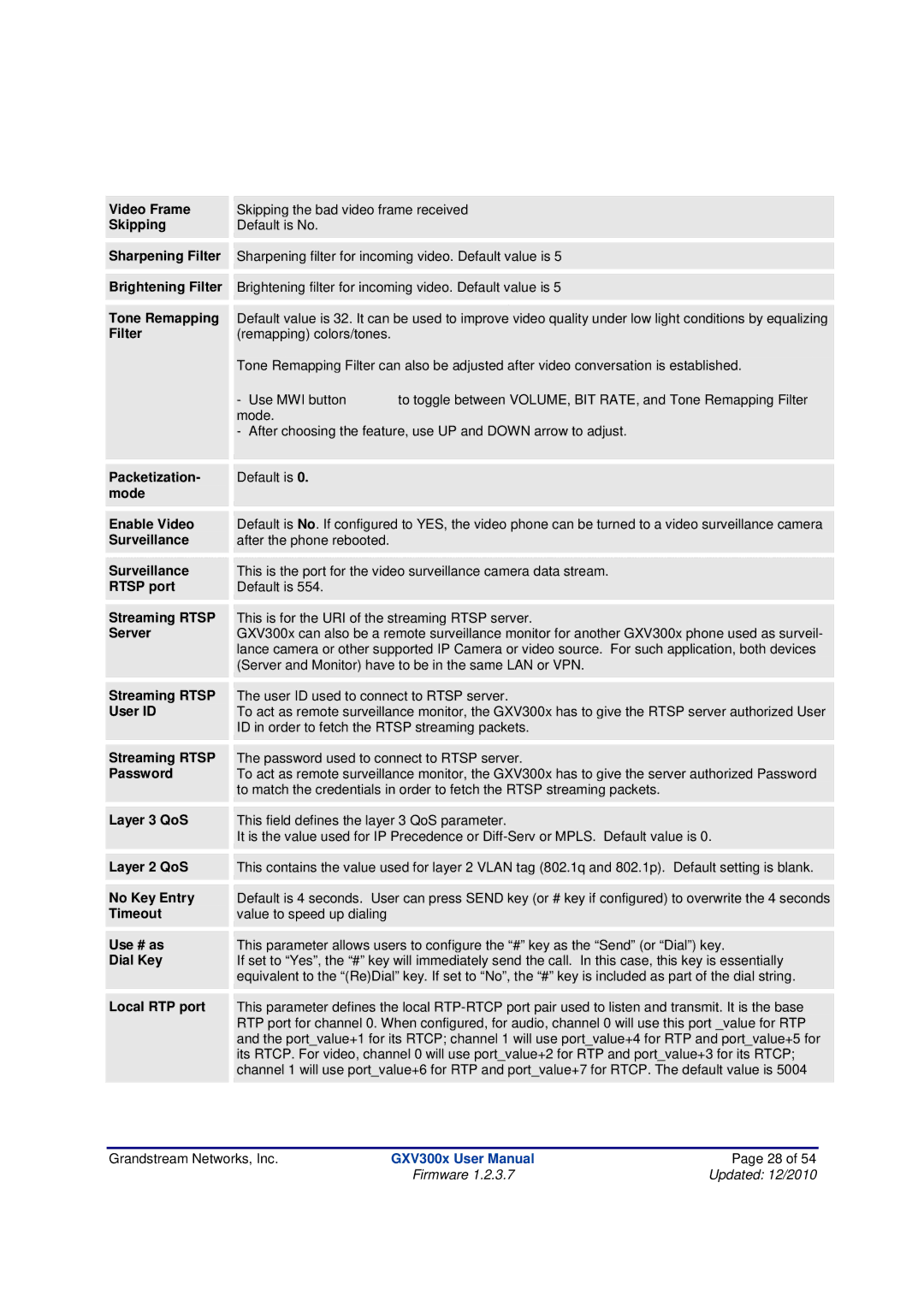
| Video Frame |
| Skipping the bad video frame received |
| |
|
|
| |||
| Skipping |
| Default is No. |
|
|
|
|
|
|
|
|
|
|
|
|
| |
| Sharpening Filter |
|
|
| |
|
| Sharpening filter for incoming video. Default value is 5 |
| ||
|
|
|
|
|
|
|
|
|
|
| |
| Brightening Filter |
|
|
| |
|
| Brightening filter for incoming video. Default value is 5 |
| ||
|
|
|
|
|
|
|
|
|
|
| |
| Tone Remapping |
|
|
| |
|
| Default value is 32. It can be used to improve video quality under low light conditions by equalizing |
| ||
| Filter |
| (remapping) colors/tones. |
|
|
|
|
| Tone Remapping Filter can also be adjusted after video conversation is established. |
| |
|
|
| - Use MWI button | to toggle between VOLUME, BIT RATE, and Tone Remapping Filter |
|
|
|
| mode. |
|
|
|
|
| - After choosing the feature, use UP and DOWN arrow to adjust. |
| |
|
|
|
|
|
|
|
|
|
|
|
|
|
|
|
|
|
|
| Packetization- |
| Default is 0. |
|
|
|
|
|
| ||
| mode |
|
|
|
|
|
|
|
|
|
|
|
|
|
|
| |
| Enable Video |
| Default is No. If configured to YES, the video phone can be turned to a video surveillance camera |
| |
|
|
| |||
| Surveillance |
| after the phone rebooted. |
|
|
|
|
|
|
|
|
|
|
|
|
| |
| Surveillance |
|
|
| |
|
| This is the port for the video surveillance camera data stream. |
| ||
| RTSP port |
| Default is 554. |
|
|
|
|
|
|
|
|
|
|
|
|
| |
| Streaming RTSP |
|
|
| |
|
| This is for the URI of the streaming RTSP server. |
| ||
| Server |
| GXV300x can also be a remote surveillance monitor for another GXV300x phone used as surveil- |
| |
|
|
| lance camera or other supported IP Camera or video source. For such application, both devices |
| |
|
|
| (Server and Monitor) have to be in the same LAN or VPN. |
| |
|
|
|
|
|
|
|
|
|
|
| |
| Streaming RTSP |
|
|
| |
|
| The user ID used to connect to RTSP server. |
| ||
| User ID |
| To act as remote surveillance monitor, the GXV300x has to give the RTSP server authorized User |
| |
|
|
| ID in order to fetch the RTSP streaming packets. |
| |
|
|
|
|
|
|
|
|
|
|
| |
| Streaming RTSP |
|
|
| |
|
| The password used to connect to RTSP server. |
| ||
| Password |
| To act as remote surveillance monitor, the GXV300x has to give the server authorized Password |
| |
|
|
| to match the credentials in order to fetch the RTSP streaming packets. |
| |
|
|
|
|
|
|
|
|
|
|
| |
| Layer 3 QoS |
|
|
| |
|
| This field defines the layer 3 QoS parameter. |
| ||
|
|
| It is the value used for IP Precedence or |
| |
|
|
|
|
|
|
|
|
|
|
| |
| Layer 2 QoS |
|
|
| |
|
| This contains the value used for layer 2 VLAN tag (802.1q and 802.1p). Default setting is blank. |
| ||
|
|
|
|
|
|
|
|
|
|
| |
| No Key Entry |
|
|
| |
|
| Default is 4 seconds. User can press SEND key (or # key if configured) to overwrite the 4 seconds |
| ||
| Timeout |
| value to speed up dialing |
|
|
|
|
|
|
|
|
|
|
|
|
| |
| Use # as |
|
|
| |
|
| This parameter allows users to configure the “#” key as the “Send” (or “Dial”) key. |
| ||
| Dial Key |
| If set to “Yes”, the “#” key will immediately send the call. In this case, this key is essentially |
| |
|
|
| equivalent to the “(Re)Dial” key. If set to “No”, th e “#” key is included as part of the dial string. |
| |
|
|
|
|
|
|
|
|
|
|
| |
| Local RTP port |
|
|
| |
|
| This parameter defines the local |
| ||
|
|
| RTP port for channel 0. When configured, for audio, channel 0 will use this port _value for RTP |
| |
|
|
| and the port_value+1 for its RTCP; channel 1 will use port_value+4 for RTP and port_value+5 for |
| |
|
|
| its RTCP. For video, channel 0 will use port_value+2 for RTP and port_value+3 for its RTCP; |
| |
|
|
| channel 1 will use port_value+6 for RTP and port_value+7 for RTCP. The default value is 5004 |
| |
|
|
|
|
|
|
Grandstream Networks, Inc. | GXV300x User Manual | Page 28 of 54 |
| Firmware 1.2.3.7 | Updated: 12/2010 |
